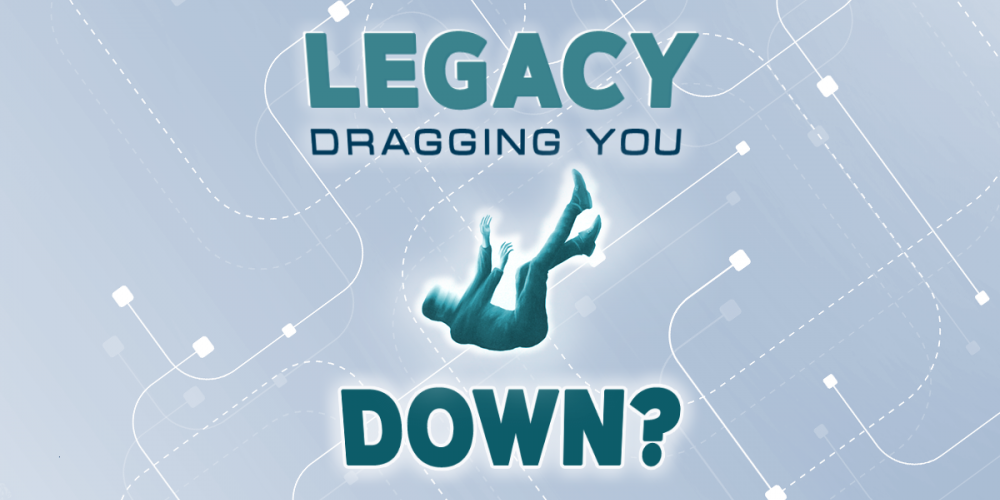
Innovation Drag: How Legacy Systems Hold Back IT Teams, Budgets, and Modernization
In the modern enterprise, agility and speed are no longer competitive advantages—they are survival tools. Yet for organizations, legacy systems act like an anchor, slowing progress and draining resources. “Innovation drag” or the friction that leads to the slowdown, prevents IT teams from kicking off digitization and modernization projects at the pace business demands.
Innovation drag can quietly undermine an organization’s ability to compete, and throttle team momentum.
What Is Innovation Drag?
Innovation drag (from an IT perspective) is the reduction of a team’s capacity to deliver new capabilities due to, excessive amounts of time and money, being spent to keep old systems running. Instead of investing in future-ready solutions, resources are tied up in “keeping the lights on.”
For many CIOs, the statistics are sobering:
- 60–80% of IT budgets are spent maintaining existing systems rather than building new ones (Gartner, 2023).
- Legacy systems can be 10x more expensive to maintain than modern equivalents over a 10-year period due to complexity and specialized skill requirements.
- Outdated technology increases downtime risk, costing an average of $5,600 per minute in lost productivity and revenue (Gartner, 2023).
How Legacy Systems Create Innovation Drag
1. Maintenance Overload
Legacy systems demand constant attention– patches, manual updates, hardware support, and integration fixes.
- These tasks do not produce new value.
- They consume skilled developers who could otherwise be innovating.
- They decrease team morale and can lead to developer burnout.
2. Integration Bottlenecks
Modern tools rely on APIs and microservices, but many legacy platforms:
- Use proprietary data formats.
- Lack robust integration capabilities.
- Require custom, one-off connectors that are costly and brittle (leading to maintenance overload).
3. Talent Drain
As technologies age, fewer developers possess the knowledge to work on them.
- Hero team member dependency – the same team member who repeatedly swoops in to fix the urgent issues. Reliance on a single team member can contribute to team dissatisfaction and further software instability.
- Senior staff bottleneck – for many development teams these are the only folks who know the system(s) and can work with its unique intricacies.
- Recruiting replacements becomes increasingly difficult and expensive often requiring third party head-hunters to find these “urban legends” in the developer landscape.
4. Security Risks
Older systems struggle to meet modern security standards without expensive workarounds.
- This diverts budget from modernization efforts into compliance and risk mitigation.
- Tech Debt can lead to outdated components and legacy platforms increasing vulnerability to cyber criminals.
- Heavily regulated industries like Pharma, Healthcare, and Finance face non-compliance violations often due to the non agile environments.
The Human Side of Innovation Drag
Innovation drag isn’t just an IT issue, it’s a major HR challenge.
- Frustration Over “Monotonous Work”
- Skilled developers want to solve unfamiliar problems, or create new products, not endlessly patch outdated code.
- When innovation has roadblocks, creativity, and motivation decline.
- Frustration leads to engagement challenges, decreased productivity and can eventually attrition.
- Burnout from Crisis Management
- Legacy systems often fail unpredictably, creating a culture of firefighting instead of proactive planning.
- Constant pressure to “keep things running” leaves no time for professional growth and skills development.
- Burnout is leading to physical and mental health challenges with IT staff with the highest levels among engineers and cybersecurity professionals
- Skill Stagnation
- Developers stuck managing outdated systems lose touch with emerging tools and frameworks.
- This reduces long-term career prospects, further lowers morale and increasing turnover.
- Skill stagnation is among the highest reasons for voluntary employee departure with 75% of Millennial and GenZ workers leading the charge.
- High Turnover
- Senior developers are often allocated to legacy projects leaving junior staff on newer more exciting projects, leading to increased, costly attrition.
- Talented knowledge workers often leave for organizations for opportunities to work with modern, marketable technology stacks.
- High turnover can lead to difficulty in recruitment efforts due to a company’s poor reputation for employee satisfaction.
Budgetary Consequences of Innovation Drag
Innovation drag reshapes the IT budget in ways that make modernization even harder over time.
The 80/20 Trap
In many organizations, 60-80% of IT spend goes to maintaining legacy systems, leaving as little as 20% for innovation.
- Incremental updates instead of transformative change.
- Long project timelines that reduce ROI and stakeholder patience.
Hidden Costs
- Downtime Costs: Every hour of downtime in manufacturing, finance, or healthcare can cost millions. Digital Insights does an excellent job of highlighting the legacy Paradox and the downtime costs.
- Vendor Lock-In Fees: Proprietary legacy software often comes with expensive licensing and support contracts.
- Training Costs: Maintaining staff competency in outdated systems requires specialized (and increasingly rare) training.
- Recruiting Costs: Replacing team members who carry a significant amount of legacy knowledge is expensive, often costing up to $20,000 plus salary and training.
Modernization Delay Penalties
The longer modernization is postponed:
- The larger the technology gap grows.
- The higher the eventual replacement cost becomes.
Breaking Free from Innovation Drag
While there is no “one-click” fix, there are strategic options we recommend that can reduce innovation drag over time.
1. Assess and Prioritize
Conduct a legacy system audit to:
- Identify the systems that cause the most downtime, cost, or integration pain.
- Prioritize modernization efforts based on ROI and business impact.
- Consider a software audit to ensure security and regulatory compliance.
2. Adopt Incremental Modernization
Techniques like the Strangler Fig Pattern allow organizations to replace legacy components gradually, reducing risk and maintaining business continuity.
3. Automate Maintenance
Use monitoring tools, patch management software, and automated testing to reduce manual intervention in legacy environments.
4. Collaborate with HR
Your human resources team can be instrumental in ensuring the team stays motivated, their skills continue to expand, and their overall job (dis)satisfaction does not lead to turnover.
5. Outsource Strategically
Third-party vendors can help free up internal teams to focus on innovation. Third party vendors, like STEP Software, who offer both staff augmentation and custom development services, have a portfolio of services that can help in several areas at once.
A Case for Third-Party Support
Outsourcing parts of your legacy maintenance or modernization can dramatically reduce innovation drag. Many providers can also provide advice or guidance on how to build a legacy modernization strategy.
Benefits
- Specialized Expertise: Vendors often have teams skilled in both legacy and modern tech. Their diversity in talent can help with:
- Maintenance of legacy systems.
- Specialized modernization projects.
- Integrated team solutions to help expand your team during times of high demand.
- Decreased onboarding time, third party developers can often hit the ground running with limited ramp time.
- Predictable Costs: Fixed pricing models replace unpredictable internal costs.
- Faster Delivery: Dedicated project teams can modernize faster than in-house teams balancing daily operations.
Risks
- Dependency on Vendor: Over-reliance can limit internal skill development.
- Alignment Challenges: Vendors must fully understand your business priorities to deliver real value. We’ve written about the importance of vendor fit in the past.
Financial Upside
Organizations that successfully reduce innovation drag often see:
- Lower Operational Costs by 20–40% due to reduced downtime and streamlined maintenance.
- Faster Time-to-Market for new products and services.
These benefits compound over time, creating a positive innovation cycle where budget freed from maintenance reinvested into further modernization.
Conclusion
Innovation Drag caused by legacy systems is more than a technical inconvenience, it is a systemic business threat. Draining budgets, stifling innovation, frustrating IT teams and slowing modernization efforts are only some of the impacts it has on a company.
The solution doesn’t need to be rip and replace; it’s it should be about strategic, prioritized action:
- Understand the scope of the problem.
- Invest in gradual modernization.
- Free up your best people for innovation by offloading routine maintenance to a trusted third-party vendor.
By addressing innovation drag head-on, organizations can transform their legacy systems from a burden into a stepping stone toward modernization, giving their IT teams the freedom to do what they do best.


